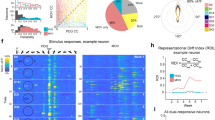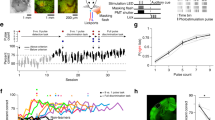Abstract
Experience-dependent plasticity in adult visual cortex is believed to have important roles in visual coding and perceptual learning. Here we show that repeated stimulation with movies of natural scenes induces a rapid improvement in response reliability in cat visual cortex, whereas stimulation with white noise or flashed bar stimuli does not. The improved reliability can be accounted for by a selective increase in spiking evoked by preferred stimuli, and the magnitude of improvement depends on the sparseness of the response. The increase in reliability persists for at least several minutes in the absence of further movie stimulation. During this period, spontaneous spiking activity shows detectable reverberation of the movie-evoked responses. Thus, repeated exposure to natural stimuli not only induces a rapid improvement in cortical response reliability, but also leaves a 'memory trace' in subsequent spontaneous activity.
This is a preview of subscription content, access via your institution
Access options
Subscribe to this journal
Receive 12 print issues and online access
$209.00 per year
only $17.42 per issue
Buy this article
- Purchase on Springer Link
- Instant access to full article PDF
Prices may be subject to local taxes which are calculated during checkout







Similar content being viewed by others
References
Maffei, L., Fiorentini, A. & Bisti, S. Neural correlate of perceptual adaptation to gratings. Science 182, 1036–1038 (1973).
Movshon, J.A. & Lennie, P. Pattern-selective adaptation in visual cortical neurones. Nature 278, 850–852 (1979).
Muller, J.R., Metha, A.B., Krauskopf, J. & Lennie, P. Rapid adaptation in visual cortex to the structure of images. Science 285, 1405–1408 (1999).
Dragoi, V., Sharma, J. & Sur, M. Adaptation-induced plasticity of orientation tuning in adult visual cortex. Neuron 28, 287–298 (2000).
Carandini, M. & Ferster, D. A tonic hyperpolarization underlying contrast adaptation in cat visual cortex. Science 276, 949–952 (1997).
Sanchez-Vives, M.V., Nowak, L.G. & McCormick, D.A. Membrane mechanisms underlying contrast adaptation in cat area 17 in vivo. J. Neurosci. 20, 4267–4285 (2000).
Chance, F.S., Nelson, S.B. & Abbott, L.F. Synaptic depression and the temporal response characteristics of V1 cells. J. Neurosci. 18, 4785–4799 (1998).
Eysel, U.T., Eyding, D. & Schweigart, G. Repetitive optical stimulation elicits fast receptive field changes in mature visual cortex. Neuroreport 9, 949–954 (1998).
Hebb, D.O. The Organization of Behavior (Wiley, New York, 1949).
Fu, Y.X. et al. Temporal specificity in the cortical plasticity of visual space representation. Science 296, 1999–2003 (2002).
Yao, H. & Dan, Y. Stimulus timing-dependent plasticity in cortical processing of orientation. Neuron 32, 315–323 (2001).
Yao, H., Shen, Y. & Dan, Y. Intracortical mechanism of stimulus-timing-dependent plasticity in visual cortical orientation tuning. Proc. Natl. Acad. Sci. USA 101, 5081–5086 (2004).
Markram, H., Lubke, J., Frotscher, M. & Sakmann, B. Regulation of synaptic efficacy by coincidence of postsynaptic APs and EPSPs. Science 275, 213–215 (1997).
Bi, G.Q. & Poo, M.M. Synaptic modifications in cultured hippocampal neurons: dependence on spike timing, synaptic strength, and postsynaptic cell type. J. Neurosci. 18, 10464–10472 (1998).
Chapman, B. & Stryker, M.P. Development of orientation selectivity in ferret visual cortex and effects of deprivation. J. Neurosci. 13, 5251–5262 (1993).
Li, Y., Fitzpatrick, D. & White, L.E. The development of direction selectivity in ferret visual cortex requires early visual experience. Nat. Neurosci. 9, 676–681 (2006).
Crist, R.E., Li, W. & Gilbert, C.D. Learning to see: experience and attention in primary visual cortex. Nat. Neurosci. 4, 519–525 (2001).
Schoups, A., Vogels, R., Qian, N. & Orban, G. Practising orientation identification improves orientation coding in V1 neurons. Nature 412, 549–553 (2001).
Fahle, M. & Poggio, T. Perceptual Learning (MIT Press, Cambridge, Massachusetts, USA, 2002).
Furmanski, C.S., Schluppeck, D. & Engel, S.A. Learning strengthens the response of primary visual cortex to simple patterns. Curr. Biol. 14, 573–578 (2004).
Li, W., Piech, V. & Gilbert, C.D. Perceptual learning and top-down influences in primary visual cortex. Nat. Neurosci. 7, 651–657 (2004).
Barlow, H.B. Single units and sensation: a neuron doctrine for perceptual psychology? in Sensory Communication (ed. Rosenblith, W.A.) 217–234 (MIT Press, Cambridge, Massachusetts, 1961).
Olshausen, B.A. & Field, D.J. Emergence of simple-cell receptive field properties by learning a sparse code for natural images. Nature 381, 607–609 (1996).
Vinje, W.E. & Gallant, J.L. Sparse coding and decorrelation in primary visual cortex during natural vision. Science 287, 1273–1276 (2000).
Abeles, M. & Gerstein, G.L. Detecting spatiotemporal firing patterns among simultaneously recorded single neurons. J. Neurophysiol. 60, 909–924 (1988).
Nadasdy, Z., Hirase, H., Czurko, A., Csicsvari, J. & Buzsaki, G. Replay and time compression of recurring spike sequences in the hippocampus. J. Neurosci. 19, 9497–9507 (1999).
Dave, A.S. & Margoliash, D. Song replay during sleep and computational rules for sensorimotor vocal learning. Science 290, 812–816 (2000).
Louie, K. & Wilson, M.A. Temporally structured replay of awake hippocampal ensemble activity during rapid eye movement sleep. Neuron 29, 145–156 (2001).
Kenet, T., Bibitchkov, D., Tsodyks, M., Grinvald, A. & Arieli, A. Spontaneously emerging cortical representations of visual attributes. Nature 425, 954–956 (2003).
Ikegaya, Y. et al. Synfire chains and cortical songs: temporal modules of cortical activity. Science 304, 559–564 (2004).
Foster, D.J. & Wilson, M.A. Reverse replay of behavioural sequences in hippocampal place cells during the awake state. Nature 440, 680–683 (2006).
Frenkel, M.Y. et al. Instructive effect of visual experience in mouse visual cortex. Neuron 51, 339–349 (2006).
Stopfer, M. & Laurent, G. Short-term memory in olfactory network dynamics. Nature 402, 664–668 (1999).
Tulving, E. & Schacter, D.L. Priming and human memory systems. Science 247, 301–306 (1990).
Saul, A.B. & Cynader, M.S. Adaptation in single units in visual cortex: the tuning of aftereffects in the spatial domain. Vis. Neurosci. 2, 593–607 (1989).
Froemke, R.C. & Dan, Y. Spike-timing-dependent synaptic modification induced by natural spike trains. Nature 416, 433–438 (2002).
Sjostrom, P.J. & Nelson, S.B. Spike timing, calcium signals and synaptic plasticity. Curr. Opin. Neurobiol. 12, 305–314 (2002).
Steriade, M., Nunez, A. & Amzica, F. A novel slow (<1 Hz) oscillation of neocortical neurons in vivo: depolarizing and hyperpolarizing components. J. Neurosci. 13, 3252–3265 (1993).
Gais, S., Plihal, W., Wagner, U. & Born, J. Early sleep triggers memory for early visual discrimination skills. Nat. Neurosci. 3, 1335–1339 (2000).
Stickgold, R., James, L. & Hobson, J.A. Visual discrimination learning requires sleep after training. Nat. Neurosci. 3, 1237–1238 (2000).
Steriade, M. & Timofeev, I. Neuronal plasticity in thalamocortical networks during sleep and waking oscillations. Neuron 37, 563–576 (2003).
Abbott, L.F. & Blum, K.I. Functional significance of long-term potentiation for sequence learning and prediction. Cereb. Cortex 6, 406–416 (1996).
Rao, R.P.N. & Sejnowski, T.J. (eds.) Predictive Sequence Learning in Recurrent Neocortical Circuits (MIT Press, Cambridge, Massachusetts, USA, 2000).
Bi, G. & Poo, M. Distributed synaptic modification in neural networks induced by patterned stimulation. Nature 401, 792–796 (1999).
Attneave, F. Some informational aspects of visual perception. Psychol. Rev. 51, 183–193 (1954).
Simoncelli, E.P. & Olshausen, B.A. Natural image statistics and neural representation. Annu. Rev. Neurosci. 24, 1193–1216 (2001).
Felsen, G., Touryan, J., Han, F. & Dan, Y. Cortical sensitivity to visual features in natural scenes. PLoS Biol. 3, e342 (2005).
Touryan, J., Lau, B. & Dan, Y. Isolation of relevant visual features from random stimuli for cortical complex cells. J. Neurosci. 22, 10811–10818 (2002).
van Hateren, J.H. & Ruderman, D.L. Independent component analysis of natural image sequences yields spatio-temporal filters similar to simple cells in primary visual cortex. Proc. R. Soc. Lond. B 265, 2315–2320 (1998).
Mokeichev, A. et al. Stochastic emergence of repeating cortical motifs in spontaneous membrane potential fluctuations in vivo. Neuron 53, 413–425 (2007).
Acknowledgements
We thank H. Sompolinsky for helpful discussions. This work was supported by a grant from the US National Eye Institute (EY 015180).
Author information
Authors and Affiliations
Corresponding author
Ethics declarations
Competing interests
The authors declare no competing financial interests.
Supplementary information
Supplementary Video 1
This is an example of the 30.1 s natural movies used in the experiments. (SWF 1337 kb)
Rights and permissions
About this article
Cite this article
Yao, H., Shi, L., Han, F. et al. Rapid learning in cortical coding of visual scenes. Nat Neurosci 10, 772–778 (2007). https://doi.org/10.1038/nn1895
Received:
Accepted:
Published:
Issue Date:
DOI: https://doi.org/10.1038/nn1895
This article is cited by
-
Repeated passive visual experience modulates spontaneous and non-familiar stimuli-evoked neural activity
Scientific Reports (2023)
-
Repetitive nociceptive stimulation increases spontaneous neural activation similar to nociception-induced activity in mouse insular cortex
Scientific Reports (2022)
-
Stimulus-dependent representational drift in primary visual cortex
Nature Communications (2021)
-
Cue-triggered activity replay in human early visual cortex
Science China Life Sciences (2021)
-
Natural images are reliably represented by sparse and variable populations of neurons in visual cortex
Nature Communications (2020)



